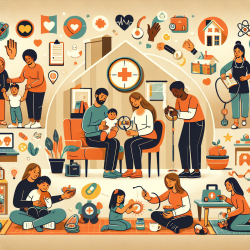Introduction
In a rapidly evolving world, the need for data-driven decisions in health care has never been more critical. The recent study titled "Preferences for Attributes of Initial COVID-19 Diagnosis in the United States and China During the Pandemic: Discrete Choice Experiment With Propensity Score Matching" provides invaluable insights into how different populations prioritize health care attributes. As practitioners, understanding these preferences can help tailor services to better meet the needs of diverse populations, ultimately leading to improved outcomes, especially for children receiving online therapy services.
Understanding Global Preferences
The study compared the preferences of individuals in the United States and China regarding initial COVID-19 diagnosis. Key findings revealed that Chinese respondents prioritized the type of medical institution, while Americans placed more emphasis on waiting time. Both groups valued higher reimbursement rates and lower costs, which are crucial factors in health care decision-making.
For practitioners, especially those involved in online therapy like TinyEYE, these insights can guide the development of more effective service delivery models. By understanding that different populations have varied preferences, practitioners can tailor their approaches to meet these needs, ensuring that children receive the best possible care.
Implications for Online Therapy Services
Online therapy services, such as those provided by TinyEYE, can benefit from these findings in several ways:
- Customized Service Delivery: By acknowledging that different populations prioritize different aspects of health care, online therapy services can customize their offerings. For example, ensuring quick access to therapy sessions can appeal to populations that value reduced waiting times.
- Focus on Accessibility: Given the importance of cost and reimbursement, practitioners should work towards making online therapy more accessible and affordable, potentially through partnerships with insurance providers.
- Enhanced Communication: Understanding the preference for certain types of medical institutions can guide how online therapy services communicate their value and reliability to clients, ensuring that families feel confident in the care their children receive.
Encouraging Further Research
While this study provides a robust foundation, it also highlights the need for further research. Practitioners are encouraged to delve deeper into understanding how these preferences might differ among specific demographics, such as children with special needs or those in rural areas. Additionally, exploring how these preferences evolve over time can provide insights into long-term service improvements.
Conclusion
Data-driven insights, like those from the study, are invaluable for practitioners dedicated to improving health outcomes for children. By leveraging these findings, online therapy services can enhance their offerings, ensuring that they meet the diverse needs of their clients. As we continue to navigate the complexities of health care delivery in a post-pandemic world, staying informed and adaptable will be key to success.
To read the original research paper, please follow this link: Preferences for Attributes of Initial COVID-19 Diagnosis in the United States and China During the Pandemic: Discrete Choice Experiment With Propensity Score Matching.










